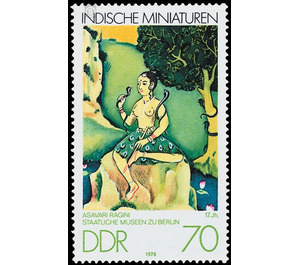Indian miniatures - Germany / German Democratic Republic 1979 - 70 Pfennig
Theme: Art & Culture
| Country | Germany / German Democratic Republic |
| Issue Date | 1979 |
| Face Value | 70.00 |
| Color | multi-colored |
| Perforation | K 14 |
| Printing Type | Rotogravure 2 |
| Stamp Type | Postage stamp |
| Item Type | Stamp |
| Chronological Issue Number | 2163 |
| Chronological Chapter | GER-DDR |
| SID | 44255 |
| In 17 Wishlists | |
Indian miniatures With the illustrations of Indian miniatures, the Ministry of Posts and Telecommunications of the German Democratic Republic issues four multicolored special postage stamps. Special cancellations from May 8 to July 7, 1979 Indian miniatures From May 23 to 30, 1979, the IV International Sanskrit Study Conference takes place in Weimar, which deals with the significant cultural heritage of the Indian people Millennia. At our universities, Sanskrit studies have a long and internationally significant tradition. In connection with them, collections of Indian manuscripts have emerged in several places as important sources for the research work to be done. These manuscripts, which date back to the 13th to the 19th century, give us works, some of which date back to the 1st millennium BC. u. Z. were created, and partly show artistically valuable illustrations (miniatures). The manuscripts of the German State Library, which are cataloged by A. Weber and W. Schubring, contain Brahman and Jain texts. The 50-pfennig and 70-pfennig-value of the series show miniatures, which belong to one of the main topics of Indian miniature painting, the Ragamala picture series. They embody pictorial representations of transformed musical moods that are bound to different day and night times. These "music-inspired" miniatures have been written since about the 16th century on the basis of literary traditions of the theory and practice of classical Indian music, for which the Sanskrit treatises of Bharata (Natyasastra, going back to the 1st century BCE), Sarngadeva (Sangitaratnakara, 1st half of the 13th century) and Damodara (Sangitadarpana, 1st quarter of the 17th century) were of particular importance. From six male perceived basic musical moods (Raga), five female-perceived melody types (Ragini) are developed, which together form a circle of 36 different sages (Ragamala). The essentially fixed iconographic program of these series sometimes shows locally related, deviant variants. The Todi Ragini appears here as a female figure in a lonely landscape, which has attracted by her play on the Vina a pair of gazelles. She embodies a loving and tender early morning manner. The Asavari Ragini, a melancholy, mournful melody that sounds at daybreak and empathizes with a mood of unhappy love, is depicted as a beaded ascetic in a peacock's gown, sitting on a boulder at dawn. Snakes, charmed by their flute playing, are their companions. Both miniatures were made in the 17th century and show the stylistic elements of Mughal painting in finely tuned colors. They come as individual sheets of a stock of about 450 Indian miniatures of the Mughal period of the 17th and 18th centuries, which, originally combined in albums, are kept in the Islamic Museum of the National Museums in Berlin (Todi Ragini: I. 4061 fol. 16; Asavari Ragini: I. 4595 fol. 21).


